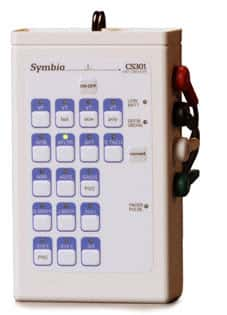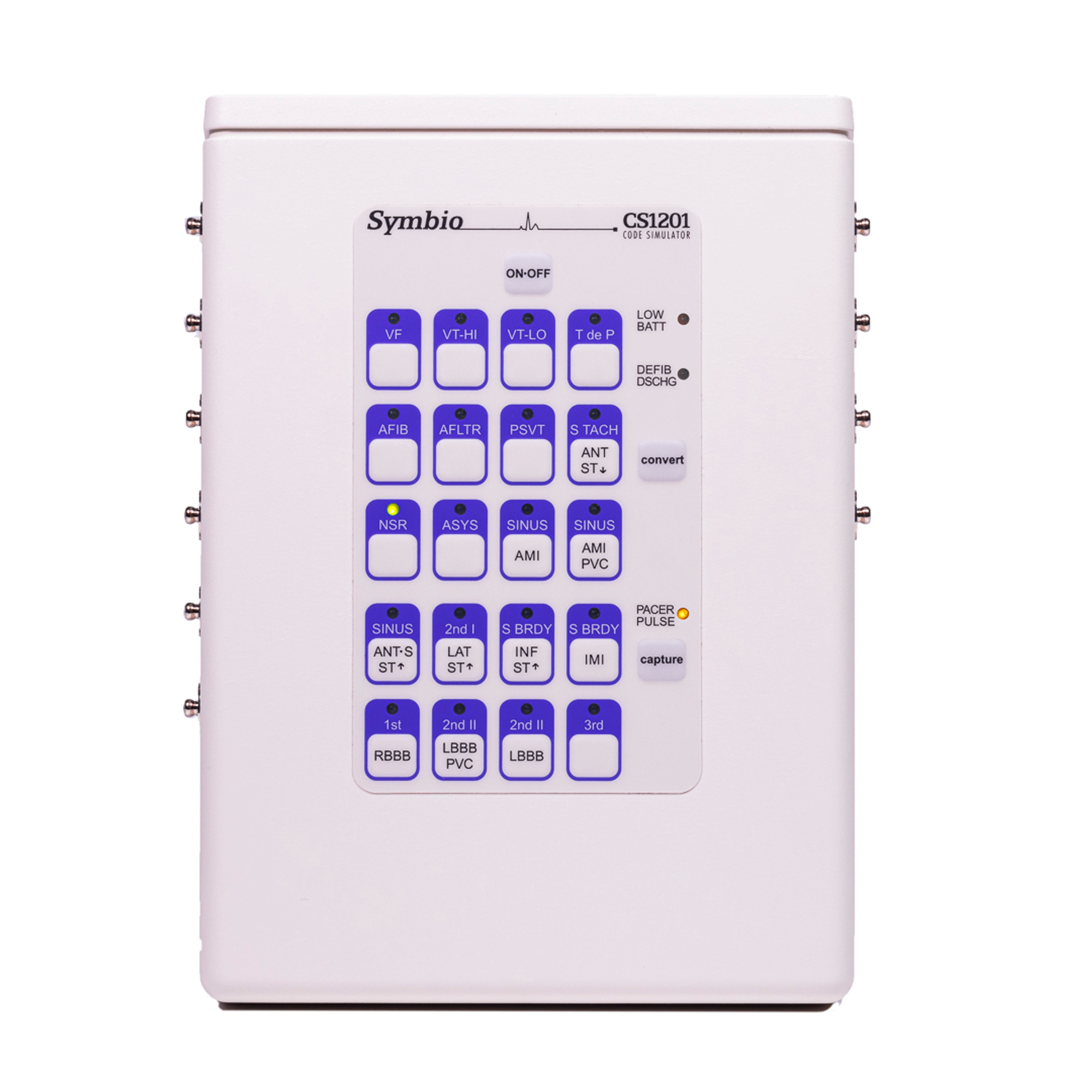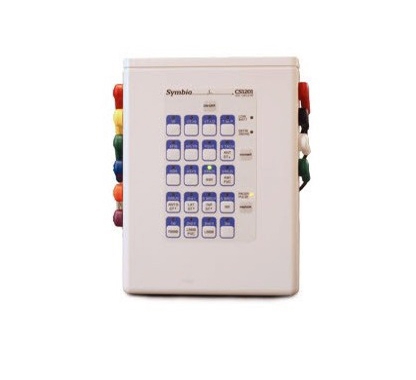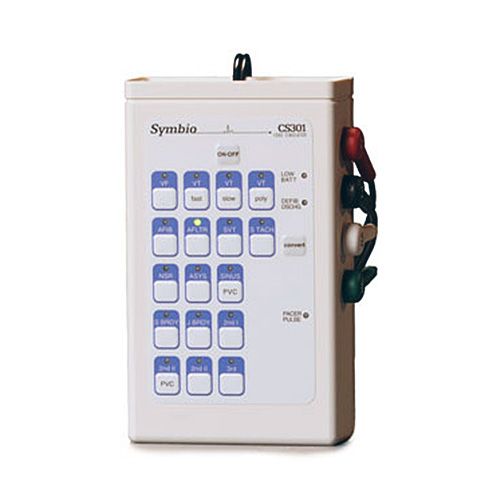Rhythm simulators depending on your needs
Select between the 12 lead CS1201 and the 3/4 lead CS301 rhythm simulators.


CS1201 Rhythm Simulator
Connect directly to your defibrillator and external pacer for safe simulation of cardioversion and electrical capture. CS1201 generates fibrillations, tachycardias, and bradycardias, as well as ST segment and T wave abnormalities.
CS301 Rhythm Simulator
Connect CS301 directly to your defibrillator and external pacer for safe, interactive training. Select from 17 ECG rhythms. They include: fibrillations, tachycardias and bradycardias.
3/4 lead - includes loadbox with Philips HeartStart end to use with Shocklink adapter against defibrillator.
Features 1
CS1201
CS301
Simulated Heart Rhythms
Ventricular Fibrillation
Ventricular Tachycardia - fast with wide QRS
Ventricular Tachycardia - slow with wide QRS
Torsades de Pointes
Atrial fibrillation with rapid varying ventricular response
Aflutter with 2:1 AV block
Paroxysmal Supraventricular Tachycardia
Sinus Tachycardia with anterior ST depression
Normal Sinus Rhythm
Asystole
1st degree AV block with RBBB
2nd degree type II AV block (4:3)
2nd degree type II AV block with LBBB and PVCs (4:3)
3rd degree AV block
Simulated Heart Rhythms
Ventricular Fibrillation
Ventricular Tachycardia - fast, wide QRS
Ventricular Tachycardia - slow, wide QRS
Ventricular Tachycardia - poly, fluctuating QRS axis
Atrial fibrillation with rapid, varying ventricular response
Aflutter with 2:1 AV block
Supraventricular Tachycardia (paroxysmal)
Sinus Tachycardia
Normal Sinus Rhythm
Asystole
Sinus rhythm with PVCs
Sinus Bradycardia
Junctional Bradycardia
2nd degree type I AV block
2nd degree type II AV block (4:3)
2nd degree type II AV block (4:3) with PVCs
3rd degree AV block
Features 2
CS1201
CS301
ECG Connections
V1 - V6
RA, LA, LL, RL
Pads
Defibrillator and Pacer Training
Defibrillator and Pacer Training - Safely discharge your defibrillator/external pacer directly into the CS1201 for interactive cardiac emergency training.
Defibrillator Discharge - The simulator detects defib discharges of 50J or greater. The DEFIB DSCHG indicator illuminates when defib detection occurs.
Convert - After you activate convert, the waiting rhythm that you pre-select automatically becomes the running rhythm when a defibrillator discharge is detected.
Pacing Capture Current - You can select four pacing capture current levels: 70, 80, 90 and 100 mA.
Paced Beats - When a pacer pulse is detected, paced beats are displayed on your ECG monitor and the PACER PULSE indicator blinks off momentarily.
ECG Connections
RA, LA, LL, RL
Pads
Defibrillator and Pacer Training
Defibrillator and Pacer Training - Safely discharge your defibrillator/external pacer directly into the CS301 for interactive cardiac emergency training.
Defibrillator Discharge - The simulator detects defib discharges of 50J or greater. The DEFIB DSCHG indicator illuminates when defib detection occurs.
Convert - After you activate convert, the waiting rhythm that you pre-select automatically becomes the running rhythm when a defibrillator discharge is detected.
Pacing Capture Current - Pacer pulses are detected when your pacer’s output current is set to 70 mA or greater.
Paced Beats - When a pacer pulse is detected, paced beats are displayed on your ECG monitor and the PACER PULSE indicator blinks off momentarily.
Features 3
CS1201
CS301
Battery
AA alkaline batteries. Low battery indicator illuminates when battery needs to be replaced. Battery saver feature powers-off the simulator automatically when not in use. Battery life is approximately 15 hours.
Rhythms for Defibrillator Training
VF: Ventricular fibrillation.
VT-HI: Ventricular Tachycardia - fast. Wide QRS. Rate: 185 bpm.
VT-LOW: Ventricular Tachycardia - slow. Wide QRS. Rate: 140 bpm.
T de P: Torsades de Pointes. Fluctuating QRS axis.
AFIB: Atrial Fibrillation. P waves absent. Rapid, varying ventricular response.
Ventricular. Rate: 154-160 bpm.
AFLTR: Atrial flutter 2:1 AV conduction. Rate: 150 bpm.
PSVT: SVT alternates with NSR, then remains in SVT Rate: 213 bpm.
PAC falls on T wave. Symmetric T wave inversion.
S TACH: Sinus Tachycardia with anterior ST depression.
ANT: Rate: 100 bpm.
ST↓
NSR: Normal Sinus Rhythm. Rate: 72 bpm.
ASYS: Asystole.
Battery
1 9V alkaline battery. Low battery indicator illuminates when battery needs to be replaced. Battery saver feature powers-off the simulator automatically when not in use. Battery life is approximately 15 hours.
Rhythms for Defibrillator Training
VF: Ventricular fibrillation.
VT-fast: Ventricular Tachycardia - fast. Wide QRS. Rate: 185 bpm.
VT-LOW: Ventricular Tachycardia. Wide QRS. Rate: 140 bpm.
VT-poly: Ventricular Tachycardia. -fluctuating QRS axis.
AFIB: Atrial Fibrillation. P waves absent. Rapid, varying ventricular response.
Ventricular. Rate: 120-160 bpm.
AFLTR: Atrial flutter 2:1 AV conduction. Rate: 150 bpm.
SVT: SVT alternates with NSR, then remains in SVT Rate: 216 bpm.
PAC falls on T wave. Symmetric T wave inversion.
S TACH: Sinus Tachycardia. Rate: 120 bpm.
NSR: Normal Sinus Rhythm. Rate: 72 bpm.
ASYS: Asystole.
SINUS: Sinus Rhythm with PVCs.
PVC: Sinus rate 72 bpm.


